Leadership Statistics By Market Growth, Retention, Demographic And Essential Qualities
Updated · Aug 09, 2024

WHAT WE HAVE ON THIS PAGE
- Introduction
- Editor’s Choice
- What is Leadership?
- Theory of Leadership
- General Leadership Statistics
- Global Leadership Development Market Growth Statistics
- Business Leadership Statistics
- COVID-19 Pandemic Leadership Statistics
- Leadership Burnout Statistics
- Leadership Training Statistics
- Remote Leadership Statistics
- Global Employee Retention Due to Leadership Statistics
- Leadership and Race Statistics
- Leadership Impact Statistics
- Leadership Demographics Statistics
- Female Leadership Statistics
- Essential Qualities of Effective Leadership
- Conclusion
Introduction
Leadership Statistics: Leadership is a key part of a company’s culture, but it needs to change and get used to new situations. Knowing leadership trends can be helpful to the leaders develop their skills. Here are some current leadership facts that businesses should be well-known for staying competitive. Leadership is always evolving, which means there are various ways to approach it. While this variety can be good, companies that need more time to be ready for these changes may need help with issues. Some leaders focus on long-term goals, while others manage day-to-day tasks. To get to know what makes a good leader today, let’s look at some important facts and Leadership Statistics about Leadership. This info helps businesses stay competitive, both within their own culture and compared to other companies.
Editor’s Choice
- The top three skills needed in leaders are empathy (17%), humility (15%), and self-awareness (7%).
- By 2024, the global corporate leadership market is expected to reach $26 billion.
- 35% of employees in the U.S. prioritize good Leadership, as stated by Leadership Statistics.
- Leadership issues cause 63% of U.S. companies to need help with keeping employees.
- 10% of CEOs are natural leaders who lead by example.
- Only 33% of employees feel engaged in their work.
- The average age of General and operations Managers is 43.8. Men in these roles are typically about 2.5 years older than women. On average, female managers are around 42.1 years old.
- 69% of workers would work harder if they felt more appreciated.
- 77% of companies think their Leadership is ineffective.
- Women hold just 20% of CEO positions.
- Only 8.2% of Fortune 500 companies are led by women.
- Leadership Statistics stated that women make up 72% of H.R. manager positions.
- Only 5% of companies have leadership development programs at every level, but 83% believe it’s important to develop leaders at all levels.
- Just 48% of employees rate their company’s Leadership as “excellent.”
- Lack of appreciation is why 79% of workers quit their jobs.
- 10% of people are natural leaders, while 20% have basic management skills that can be developed into strong Leadership.
- 78% of leaders regularly work on engaging their employees.
- The U.S. spends $166 billion a year on leadership development, and globally, it’s about $366 billion.
- 78% of leaders frequently engage with their employees.
- 77% of companies say they lack strong leadership skills, as per Leadership Statistics.
- Internal hires are 25% more likely to be chosen for leadership roles compared to external candidates.
What is Leadership?
Leadership is the ability to influence and guide others in a group, organization, or community. It is often associated with someone’s title, seniority, or position in a hierarchy. However, anyone can have or develop leadership skills, even if they don’t hold a formal leadership role. These skills can be improved over time. Leaders are needed in many areas of society, such as business, politics, religion, and community organizations. They are known for making smart and sometimes tough decisions. They create a clear vision, set achievable goals, and give others the tools and knowledge needed to reach those goals.
A good leader has these qualities: self-confidence, strong communication and management skills, creative thinking, perseverance, willingness to take risks, openness to change, and calmness during crises. In business, people with strong leadership skills can rise to high-level positions like Chief Executive Officer (CEO), Chief Information Officer (CIO), and President. Notable leaders in technology include Steve Jobs of Apple, Bill Gates of Microsoft, and Jeff Bezos of Amazon.
Theory of Leadership
The study of how people become leaders and what makes a great leader has been going on for centuries. In the 19th century, the Great Man Theory was popular. It suggested that Leadership is a special, natural skill and that great leaders are born, not made.
In the 20th century, many new leadership theories emerged:
- Trait Theory: This idea, from the mid-20th century, says that some people are born with traits like integrity and self-confidence that make them great leaders.
- Situational Leadership: This theory suggests that leaders change their style depending on their followers’ skills and readiness for different situations.
- Contingency Theory: According to this theory, effective Leadership depends on having the right leader for the specific situation.
- Transactional Leadership: This approach involves leaders giving rewards or punishments to achieve results.
- Transformational Leadership: In this type of Leadership, leaders inspire followers by appealing to their values and emotions and changing how they think and work.
- Behaviorist Theory: This theory says that leadership skills are developed through training and the environment.
- Behavioral Theory: Leaders using this approach set a good example by modeling specific behaviors for others to follow.
- Functional Theory: This theory focuses on the behaviors and group dynamics of the whole team, not just individual leaders.
- Path-Goal Theory: Leaders using this approach set goals and clear obstacles to motivate and drive their team’s performance.
General Leadership Statistics
- The leadership scene is shifting. A new generation is taking over, technology is changing leadership styles, and the global economy is setting new rules for managing businesses.
- 90% of people in a study said they have at least one woman in their top executive positions.
- 47% of leaders who are confident in their above-average leadership skills believe they are good at coaching and developing others.
- Internal promotions perform 25% better, while external hires struggle 47% of the time, and internal executive appointments fail 35% of the time due to H.R. assessments and internal hires’ senior-level skills.
- Leadership Statistics shows that in the USA, the average age for General and operations Managers is 43.8.
- Millennials, who are now between 27 and 42 years old, are replacing baby boomers and bringing new ideas and democratic leadership styles.
- However, 63% of millennials feel that their companies need to help them build their leadership skills.
- Only 18% of leaders who think they are average or below average in Leadership feel they are good at coaching others.
- Between 50% and 70% of leaders, whether hired from outside or promoted from within, fail within the first 18 months in their new roles.
- Leaders across industries still need to improve. Developing leadership skills is crucial for increasing employee engagement and overall success.
- Leadership Statistics stated that almost 83% of companies believe that leadership development should start from day one.
- However, 30% of companies need to provide proper leadership development programs, forcing ambitious and hardworking managers to learn Leadership on their own.
- 59% of managers who supervise 1-2 employees have never received formal leadership training.
- According to Leadership Statistics, when leaders successfully manage their teams and recognize their strengths, profits can rise by up to 29%.
Global Leadership Development Market Growth Statistics
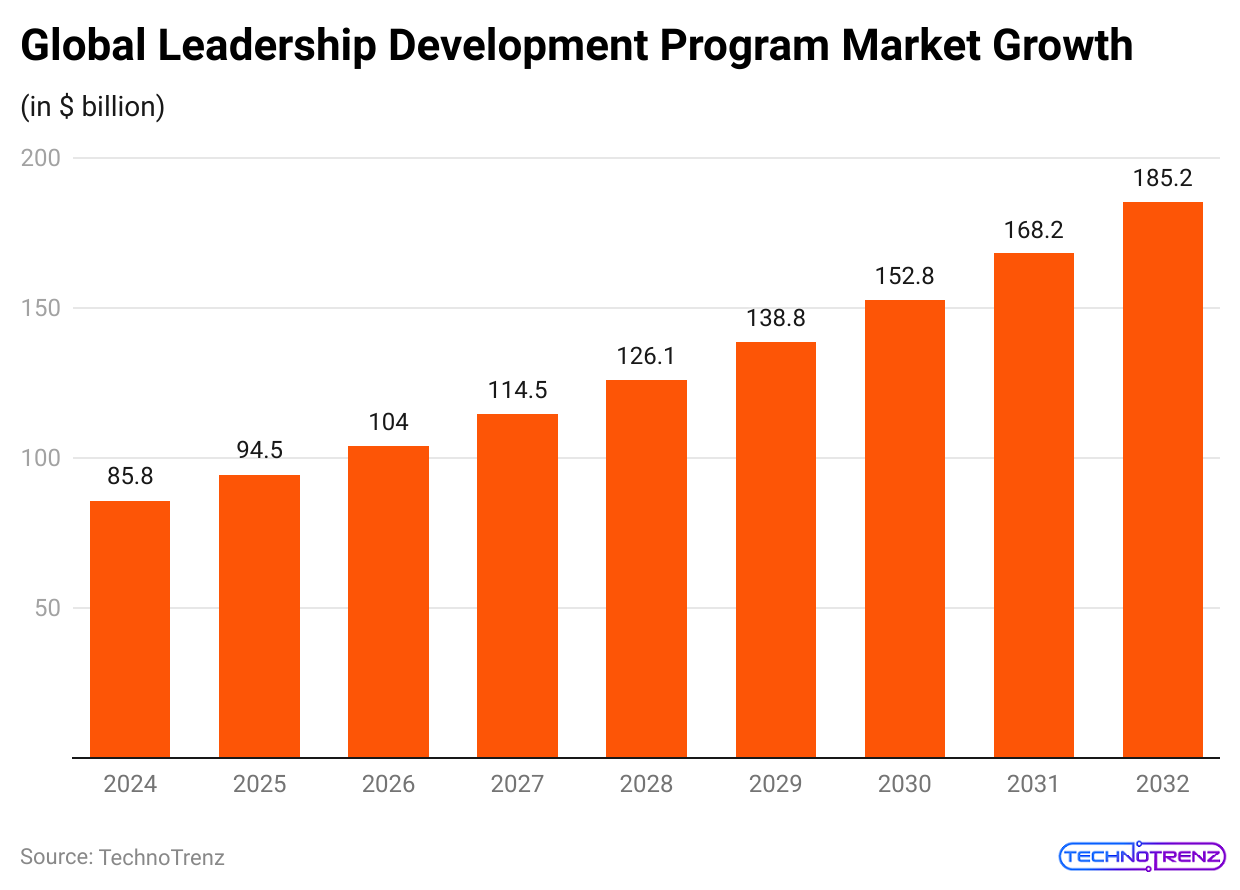 (Reference: joingenius.com)
(Reference: joingenius.com)
- A recent study showed that worldwide spending on leadership training reached $85.81 billion, highlighting a strong global focus on developing leadership skills.
|
Year |
Market Valuation Calculated Based on CAGR Forecasted |
| 2032 |
$185.20 billion |
|
2031 |
$168.22 billion |
| 2030 |
$152.80 billion |
|
2029 |
$138.79 billion |
| 2028 |
$126.07 billion |
|
2027 |
$114.51 billion |
|
2026 |
$104.01 billion |
|
2025 |
$94.47 billion |
| 2024 |
$85.81 billion |
Business Leadership Statistics
The corporate world has faced issues with leadership gaps for a while now, especially with a lack of diversity in CEO roles and the need for more candidates with the necessary leadership skills for managerial positions.
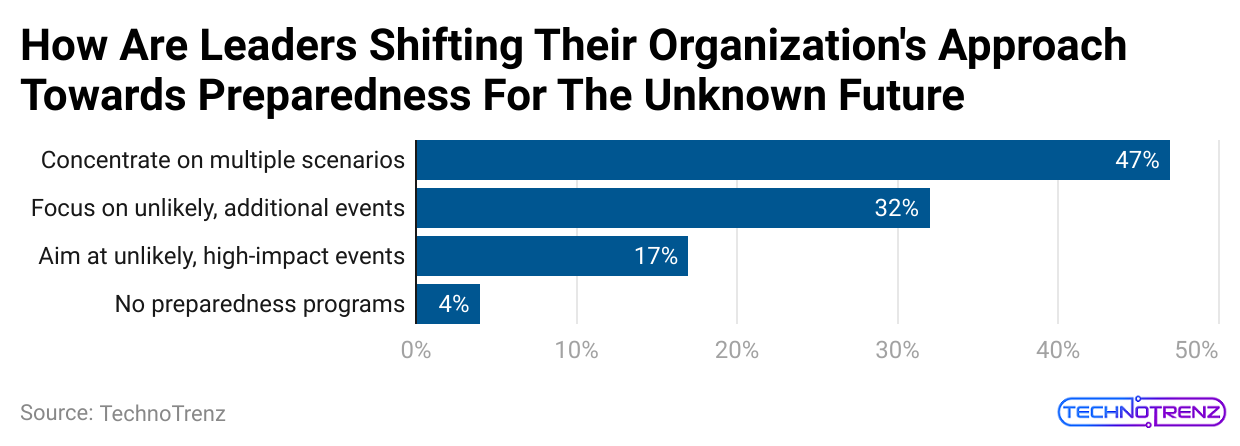 (Reference: financesonline.com)
(Reference: financesonline.com)
- Employees often look for jobs at companies that offer leadership development, but employers usually prefer candidates who already have some leadership skills.
- This is because companies don’t want to spend time or money training employees to develop these skills. This ongoing problem keeps worsening.
- In the U.S., employers spend a lot of money on training and education for their employees.
- While 83% of employers agree that developing leadership skills is important, only 5% of companies make these improvements. This might be why poor Leadership is more common than good Leadership.
- According to Leadership Statistics, 84% of employees feel that having opportunities for leadership development is crucial for moving up in their careers.
- 59% of organizations have seen improved employee retention because of their leadership development programs.
- Only 14% of CEOs have the leadership skills needed to grow their companies.
- Another study found that 71% of Millennials might leave their job within 2 to 3 years if they feel their leadership skills need to be developed, and there’s no opportunity for growth. Given that Millennials will soon make up most of the workforce, this is important.
- Finding the right candidates for leadership roles is challenging. CEOs need candidates with strong personalities for managerial roles, but only some have the skills required for the job.
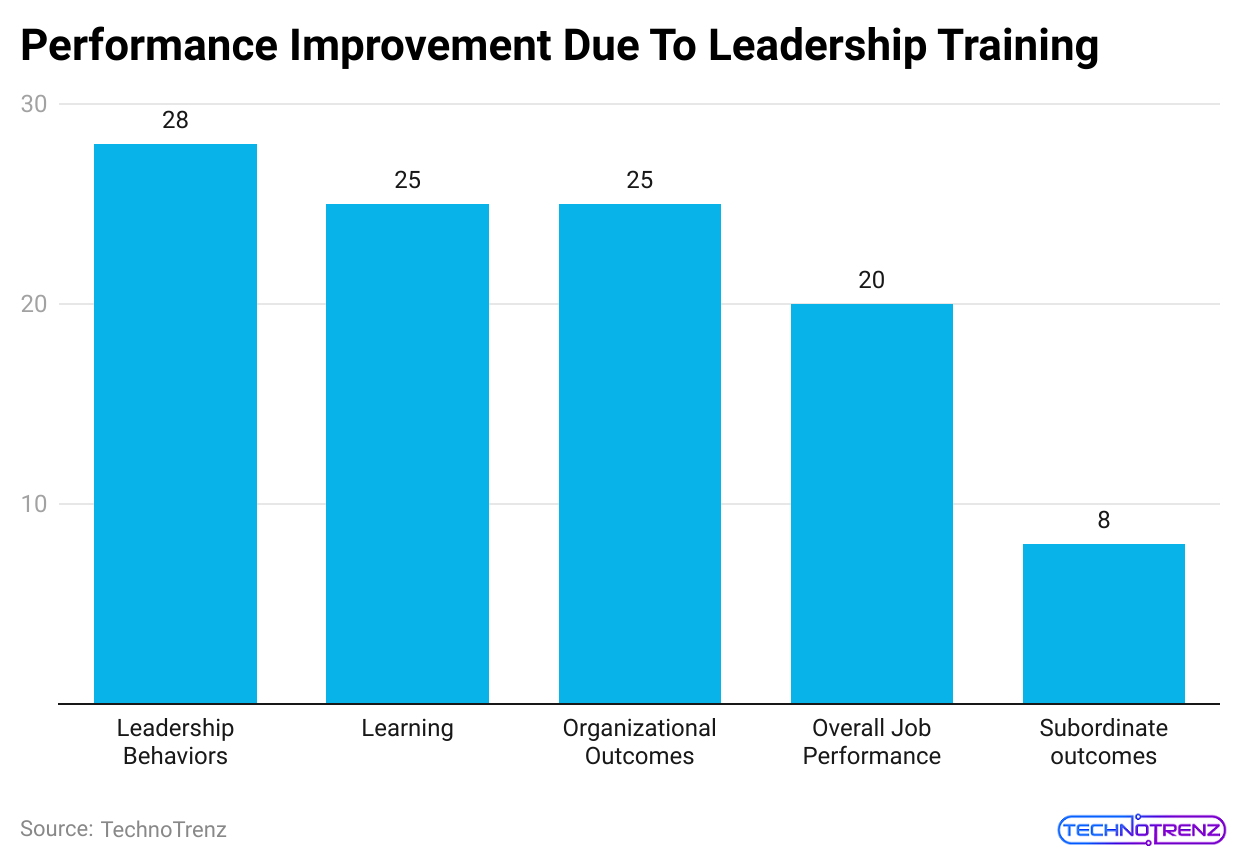 (Reference: research.com)
(Reference: research.com)
- The demand for digital leadership skills will rise in 2020, with only 16% of companies successful in digital marketing.
- The fast growth of social media and digital marketing means there will be more need for candidates with digital skills. Social media management positions are increasing daily.
- By 2025, Millennials will make up 75% of the workforce.
- 88% of companies plan to upgrade their leadership development programs in the next year.
- Leadership Statistics stated that around 72% of businesses think their leadership pipeline needs to be stronger.
- 63% of organizations see leadership development as a key part of their talent strategy.
COVID-19 Pandemic Leadership Statistics
- Leaders need to be responsible and accessible in times of crisis.
- According to Leadership Statistics, during the COVID-19 pandemic, leaders from both government and organizations need to be cautious, forward-thinking, resilient, and stable.
- In a pandemic, people are public health experts and trust scientific more than non-health managers.
- Former U.S. President Donald Trump is often criticized for his poor Leadership during the pandemic. His lack of scientific knowledge and caution was seen as harmful, especially given his high position and influence.
- Just 14% of Americans wanted political leaders to manage the COVID-19 response, while 69% preferred public health and scientific leaders.
- Countries like Finland, Denmark, Iceland, Norway New Zealand, and Germany had some of the best COVID-19 responses, with death rates of around 1% (compared to the global average of 5%).
- Germany, under its Chancellor, managed to conduct up to 200,000 tests each week by mid-March 2021, thanks to a science-based approach.
- In contrast, South Korea used a systematic testing approach along with tracing, isolation, and quarantine.
- Leadership Statistics stated that CEOs in the private sector have found expertise in online communication 26% more essential in handling the pandemic.
- On the other side, the Chinese President imposed strict lockdowns, keeping over 50 million people in their homes in Hubei province.
Leadership Burnout Statistics
- Between the employees and business leaders, 59% say their organizations are taking some steps to prevent burnout. However, nearly 29% wish their companies would show more empathy.
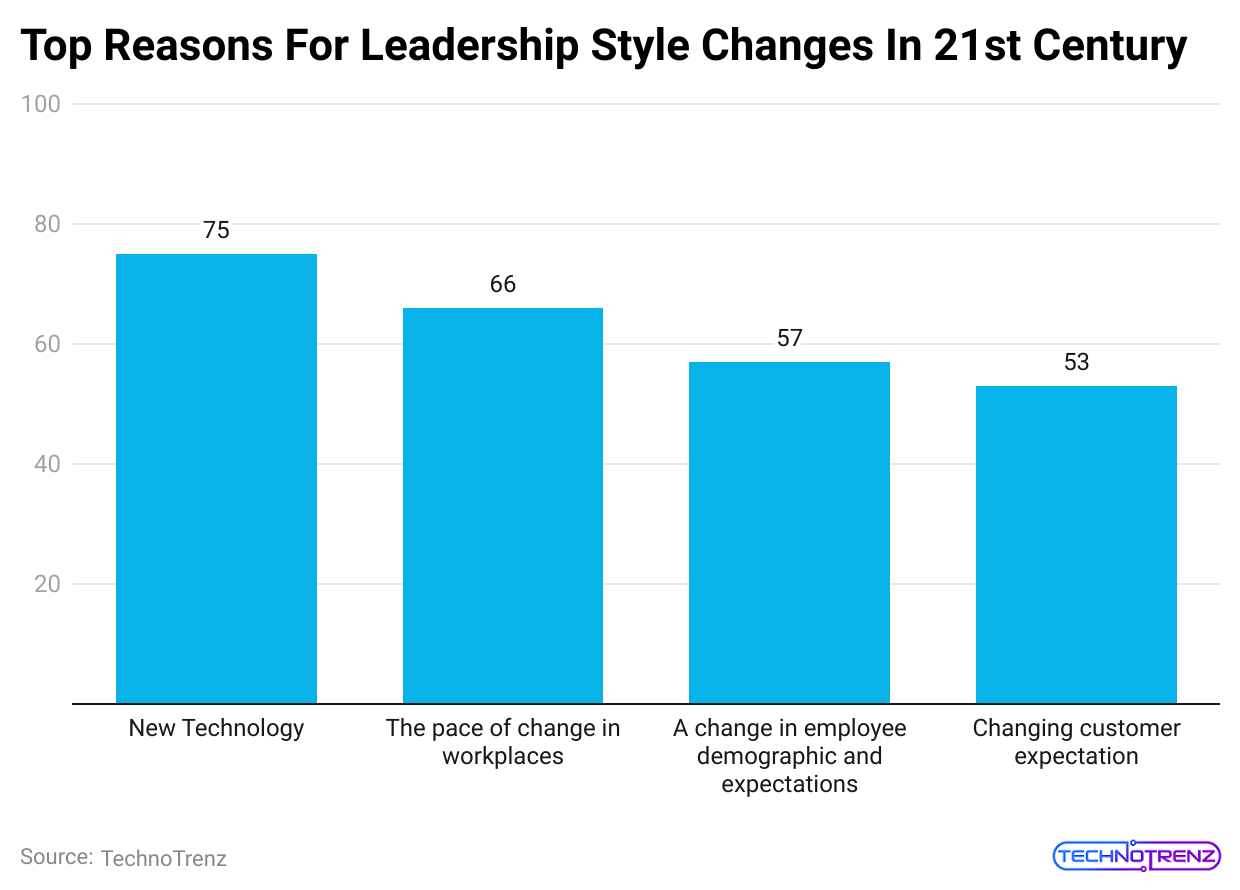 (Reference: research.com)
(Reference: research.com)
- In the above chart, we can see the reasons for the change in leadership style in the future.
- Leadership Statistics found that 44% of leaders who feel drained are considering changing companies to advance their careers. Additionally, 26% of these leaders plan to leave their current company within the next year.
- According to Leadership Statistics, almost 60% of leaders stated the feeling of exhaustion at the end of each day, which can be a sign of burnout.
- High-potential employees experience even more stress. A survey of almost 1,000 high-potential employees found that 86% felt worn out by the end of the day, which is a 27% increase from the past year.
Leadership Training Statistics
- Nearly 95% of learning organizations plan to either increase or keep their current investment in leadership development. This is because educational organizations earn a lot from this field.
- Leadership development is a $366 billion industry worldwide, with $166 billion spent in the U.S. alone.
- Leadership Statistics stated that about 69% of Millennials (people born between 1980 and 2000) feel that leadership development needs to be improved.
- Since Millennials are now a major part of the workforce and older generations like Gen Xers and baby boomers are leaving more frequently, companies need to address the leadership needs of Millennials quickly.
- When a company delays leadership development, it loses about 7% of its total annual sales.
- Leadership development is crucial for many reasons, and delaying it can cause the company’s profits to drop by 7%.
- 83% of companies think leadership development is essential at every level. H.R. and business leaders understand that developing leaders within the company is better for its financial health and overall strength.
- 79% of employees leave their jobs because they feel unappreciated. If leaders fail to show appreciation, it can lead to disengagement and early departures.
- Leaders need to find better ways to support their team members.
- According to Leadership Statistics, only 5% of companies have implemented leadership development at all business levels.
- This matches what Millennials have reported—they feel that the lack of leadership development has serious negative effects on businesses.
Remote Leadership Statistics
- Remote managers face retention problems six times more often than onsite managers.
- Getting their team to work together is twice as hard for remote managers compared to onsite managers (22% vs 10%).
- On average, remote managers have 20.9% more direct reports than onsite managers.
- Remote managers find it easier to meet team goals than onsite managers (22% vs. 14%).
- Onsite managers struggle twice as much with balancing team management and other responsibilities compared to remote managers (39% onsite vs 72% remote).
- 95% of remote managers hold one-on-one meetings with their direct reports.
- Leadership Statistics stated that half of the remote managers who have one-on-one meetings do them weekly, while 39% do them every other week.
- Managers with less than 50% of their direct reports working remotely find it challenging to provide value in one-on-one meetings.
- Managers with more than 50% of their team working remotely struggle the most with scheduling one-on-one meetings.
- Slack is the most common tool used by both remote and onsite managers to communicate with their teams.
- Leadership Statistics stated that around 50.5% of managers have at least one remote direct report, as per Leadership Statistics.
- In 2020, two-thirds (64%) of U.S. hiring managers said they have the resources to hire remote workers, but over half (57%) said they don’t have policies to support remote work.
Global Employee Retention Due to Leadership Statistics
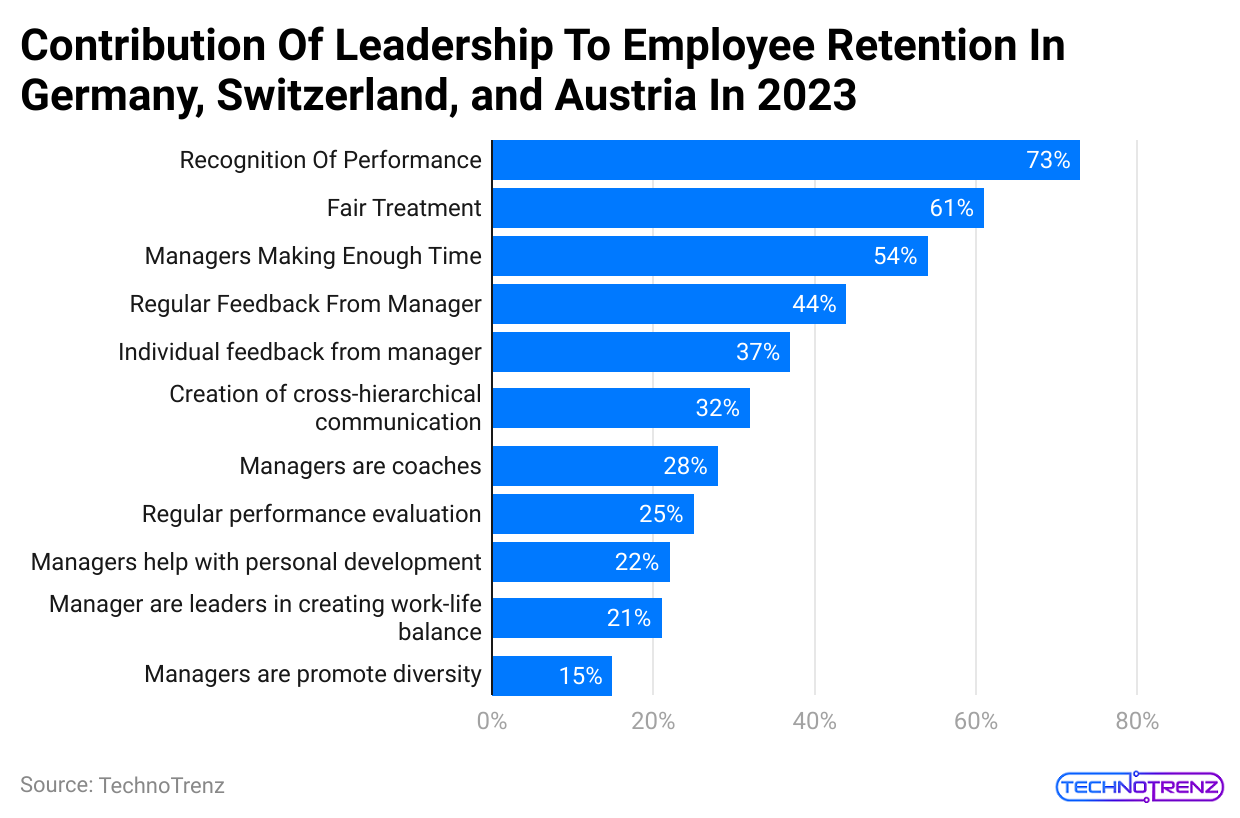 (Reference: statista.com)
(Reference: statista.com)
- In 2023, about 73% of people in Germany, Austria, and Switzerland said that recognizing performance was the most important factor for keeping employees.
- Fair treatment and managers spending enough time with their employees were also highly valued.
|
Recognition of Performance |
73% |
| Fair treatment |
61% |
|
Managers making enough time |
54% |
| Regular feedback from managers |
44% |
|
Individual feedback from managers |
37% |
| Creation of cross-hierarchical communication |
32% |
|
Managers are coaches |
28% |
| Regular performance evaluation |
25% |
|
Managers help with personnel development |
22% |
| Managers are leaders in creating work-life balance |
21% |
|
Managers promote diversity |
15% |
Leadership and Race Statistics
- According to pay scale data by race and gender, executive men from the Pacific Islands earn the highest salaries, while American Indian women earn the lowest.
- Gender and race breakdowns show that women generally earn less than men, and Hispanic and Black men earn less compared to men of other races.
- Interestingly, Asian and Pacific Islander men make the most money but are not well-represented in the workforce.
- When looking at Manager/Supervisor-level positions, using the salary of white men as a baseline, Asian women and men earn more, while all other groups earn less than white men, as stated by Leadership Statistics.
- Here is a breakdown of the 1,122 people working in Legislative Bodies and Public Administration Executive Offices.
|
White |
69.4% |
| Black or African American |
17.8% |
|
Asian |
5.0% |
| Hispanic or Latino |
12.8% |
- It’s not surprising that minorities from other races make up a smaller percentage of top and managerial roles compared to their white colleagues, based on BLS data.
- As of June 2023, there are only four Black CEOs in Fortune 500 companies.
- Lowes, Starbucks, TIAA-CREF, and Merck have black CEOs. TIAA-CREF and Starbucks have black women CEOs.
- Since the Fortune 500 list started in 1955, there have been only 19 Black CEOs. This shows a clear underrepresentation of Black individuals in top positions at Fortune 500 companies.
- One reason for this lack of diversity could be that Black individuals are not often given management opportunities early in their careers.
Leadership Impact Statistics
- Leaders who think their company’s Leadership needs more interpersonal skills are 3.5 times more likely to leave within a year.
- 90% of H.R. professionals think leaders should focus more on the human side of Leadership. However, a March 2022 Gartner survey shows that only 29% of employees feel their leader is truly human-centred.
- Leaders who feel a strong sense of purpose are nine times more likely to be engaged in their role and twice as likely to stay with the company for the next year.
- Organizations with effective leadership development programs are 6–7 times more likely to offer development opportunities throughout the company.
- In many companies, 20-30% of critical roles are filled by someone other than the best-suited people.
- About 52% of leaders introduce their employees to potential mentors.
- Leadership Statistics stated that almost 56% of leaders encourage employees to work with people outside their teams.
- Employees who report to a human-centered leader are 37% more likely to be highly engaged, which can boost team performance by up to 27%.
- Only 29% of employees say their leader is always open to using new ideas or practices from outside the company to improve performance.
- 25% of respondents say their leaders are passionate and inspire their teams effectively.
- Just 46% of leaders trust their direct manager to do what’s right, and only 32% trust senior leaders in their organization.
- Only 26% of employees feel their leader always responds constructively when they share work problems.
- Just 5% of organizations believe they have the capability they need to meet their business goals.
Leadership Demographics Statistics
- The average age of General and operations Managers is 43.8. Men in these roles are typically about 2.5 years older than women. On average, female managers are around 42.1 years old.
- Every day, about 10,000 Baby Boomers retire, many of whom are in managerial roles.
- This means Millennials and Gen Xers will need to step up and become future leaders. Currently, there are about 2 billion Millennials worldwide, with over 11 million expected to hold managerial positions in the U.S. alone.
- Millennials in management are typically between 25 and 29 years old. According to Leadership Statistics, about 53% of men and 55% of women became managers before turning 30.
- This shift is making the average age of CEOs in some industries drop from 40 to as low as 22.
- Younger people are less likely to believe women are as capable as men in leadership roles.
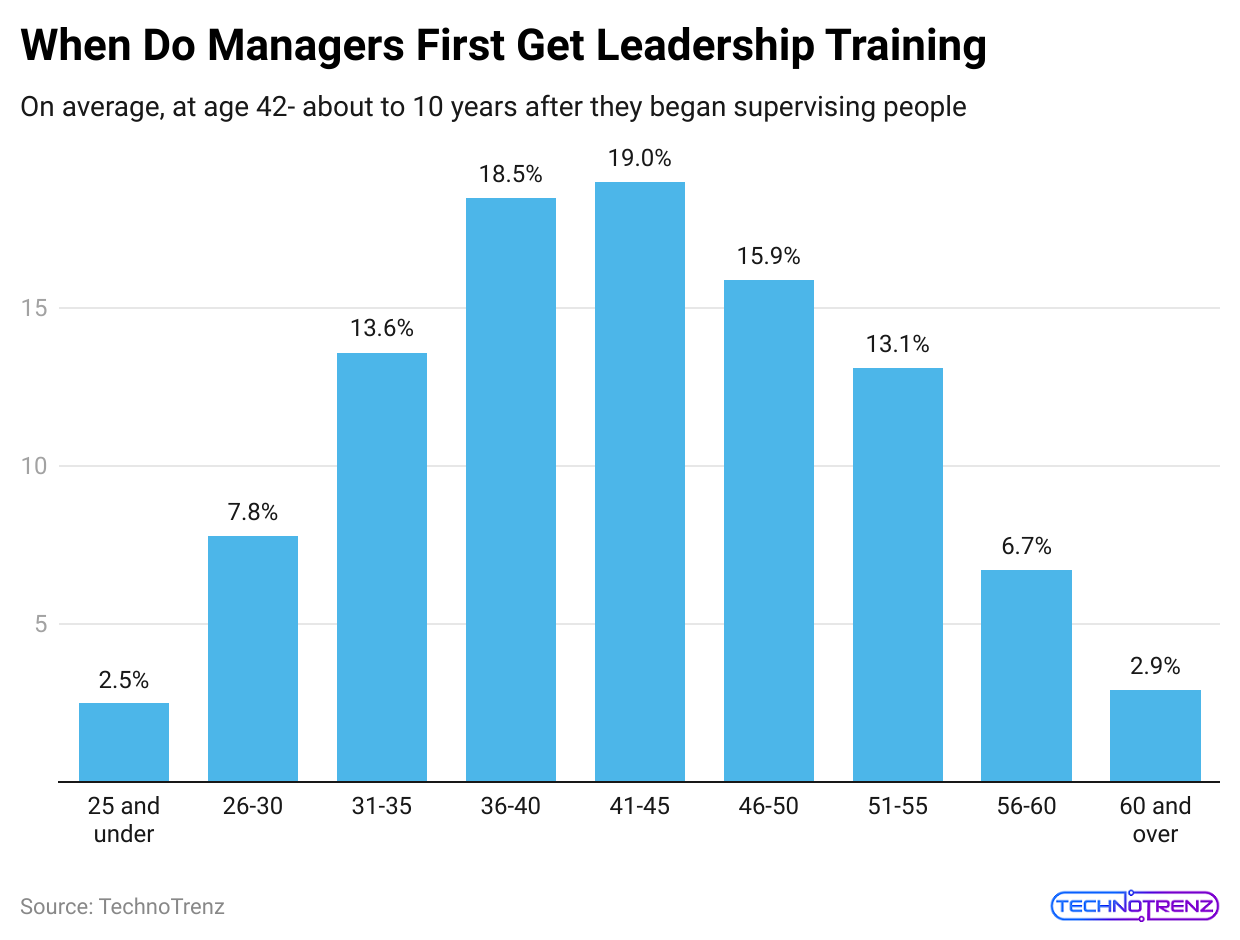 (Reference: founderjar.com)
(Reference: founderjar.com)
- In the above chart, we can see when managers first get leadership training in their careers.
|
Age |
Percentage |
| 25 and under |
2.5% |
|
26-30 |
7.8% |
| 31-35 |
13.6% |
|
36-40 |
18.5% |
| 41-45 |
19.0% |
|
46-50 |
15.9% |
| 51-55 |
13.1% |
|
56-60 |
6.7% |
| 60 and over |
2.9% |
- A recent survey found that 72% of people aged 18 to 34 in G7 countries think men and women are equally good leaders.
- In contrast, 76% of older people (ages 55-66) believe in equal leadership capabilities for both genders.
- Only four Black CEOs lead Fortune 500 companies. 60% of Black executives report they have to work harder than their white colleagues to be seen as equals. Currently, no Black women are leading any Fortune 500 companies.
- Just 3% of executives are Hispanic/Latino. Latino employees are more commonly found in support roles and operations.
- According to the Leadership Statistics report, 4% of Latino workers are in senior management, 6% are managers, and 7% are professionals. The report includes data from 7 million employees across 54 countries.
- Compared to Asians, white people are 154% more likely to hold executive roles.
- Asians often face cultural stereotypes that can hinder their advancement to senior positions. Asians make up 27% of U.S. professionals but hold a smaller share of executive roles.
- White males hold 85% of executive positions in large and midsize companies.
- Despite this dominance, only 38% of the labor force is white males, while 72% consists of people from various minority groups, including white women.
Female Leadership Statistics
- Women make up 32% of top management roles in the mid-sized market, surpassing the 30% threshold for the next year.
- The very common role for females remains H.R. director, comprising 40% of these positions.
 (Reference: joingenius.com)
(Reference: joingenius.com)
- In the above chart, we see the representation of women at a higher corporate level in 2023.
|
Executives |
23% |
| Senior managers |
29% |
|
Managers |
37% |
| Professionals |
42% |
|
Support Staff |
47% |
- Women have 47% of leadership roles, and 55.9% of leadership jobs are held by women in the news and editorial departments.
- In the market, 41.3% of leadership roles are taken over by females.
- 90% of survey respondents report having nearly a single female in their C-suite or equivalent top roles.
- According to Leadership Statistics, only 16% of CEO/MD roles are held by women in APAC, while 34% are held by women in Latin America.
- By 2022, women might reach one-third representation in senior leadership roles before the 2025 target.
- Monitoring of women’s promotions has grown from 26% in 2020 to 31% in 2022.
- The tracking of women new hires also went up from 27% to 30% in the similar period.
- North America and ASEAN lead in women representation in CEO/MD roles, with 32%.
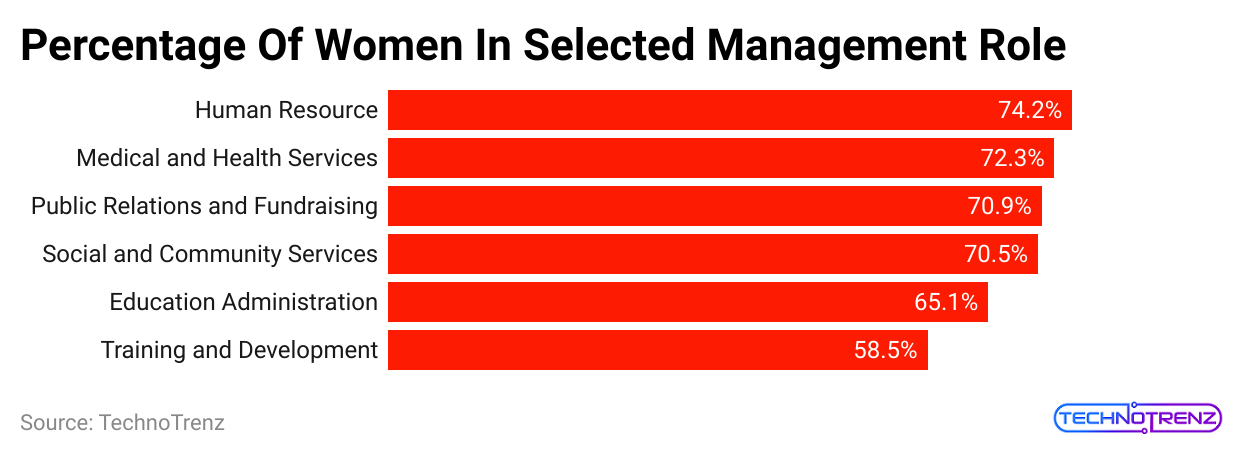 (Reference: joingenius.com)
(Reference: joingenius.com)
- In the above chart, we can see the percentage of women in selected management roles.
|
Human Resource |
74.2% |
| Medical and Health Services |
72.3% |
|
Public Relations and Fundraising |
70.9% |
| Social and Community Services |
70.5% |
|
Education Administration |
65.1% |
| Training and Development |
58.5% |
- 73% of people believe the pandemic can help women advance into higher management because of its long-term positive effects.
- Africa is a leading nation in women’s Leadership, with more businesswomen nearly in H.R. director (68%) and CMO (36%) roles.
- In 2023, APAC reached 30% female representation in senior jobs, up from 29% in 2021 and 24% in 2023.
- More women are now in managing director and CEO roles, making up 27% of such positions, according to Leadership Statistics.
- The rate of women managing directors and CEOs has grown from 16% in 2020 to 21% in 2022 and then by another seven percentage points in 2022.
- In 2024, women held 32% of higher management jobs, suggesting that 1/3rd representation is likely soon.
- The rate of females in H.R. department roles has dropped from 44% to 39% since 2019.
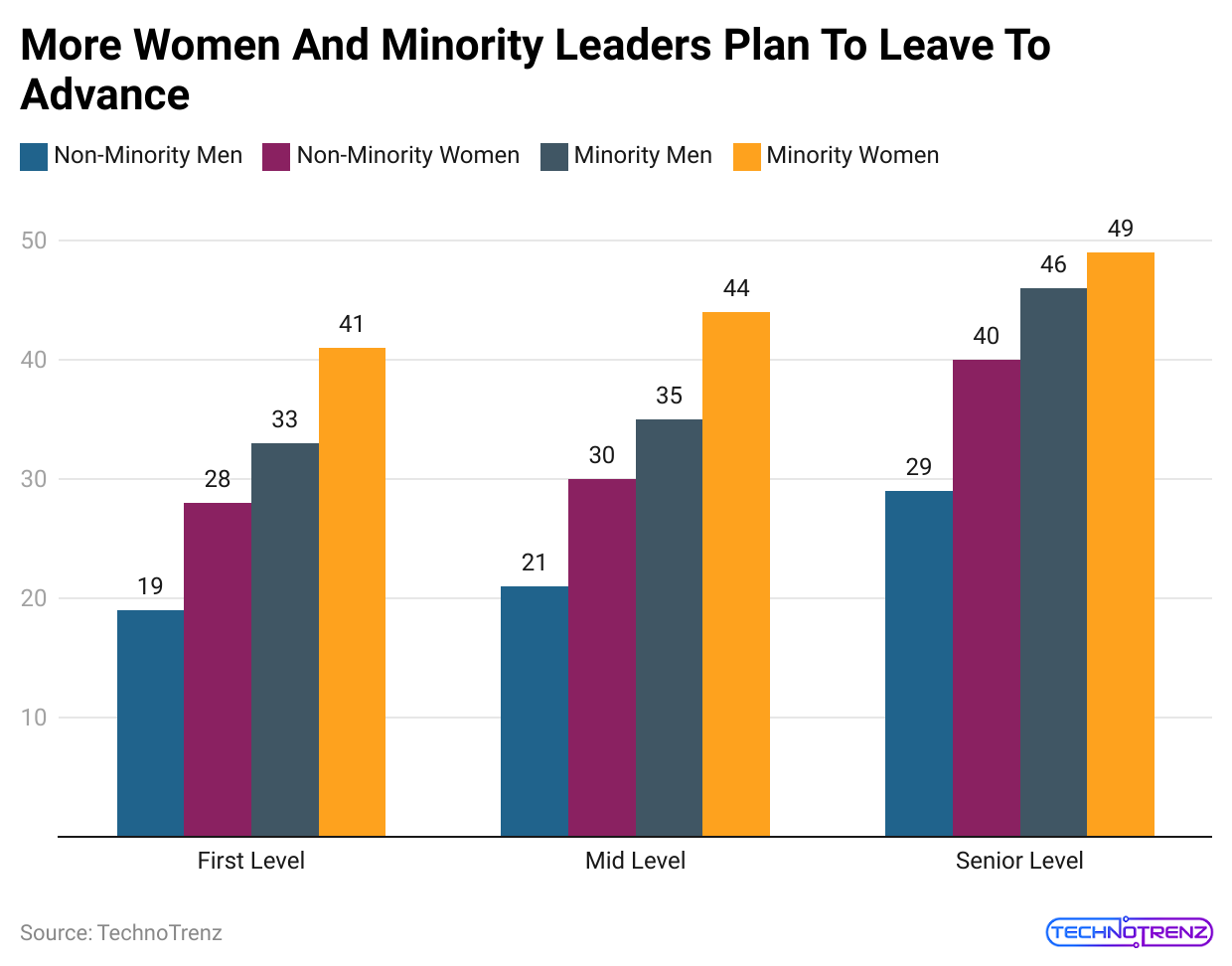 (Reference: ddiworld.com)
(Reference: ddiworld.com)
- In the above chart, we can see that more Women and Minority Leaders plan to leave to advance.
- Promoting women to 31% in leadership jobs encourages chances for future women leaders and can improve a company’s profit and industry share.
- The percentage of women in Chief Marketing Officer (CMO) roles was 17% globally in 2023.
- 31% of companies are now offering flexible work arrangements to increase women’s representation in high roles.
- In 2023, 91% of businesses had almost one woman in senior management.
- In 2023, women held 16% of higher roles worldwide, including corporate controllers.
- In 2023, women held 19% of COO positions and 40% of H.R. director positions worldwide.
- In 2019, women held only 15% of CEO/MD positions globally, rising to 17% in 2020.
- ASEAN had 38% higher positions held by females in 2021, up from 28% in 2020.
- The percentage of women in senior roles in Africa reached 39%, crossing the 30% mark.
- Latin America’s shows of females in higher management rebounded to 36%.
- In 2022, women held 24% of higher management roles. North America achieved 33% female showing in higher roles.
- By 2023, almost 90% of the market worldwide had almost one female in their higher management teams.
- The pandemic’s impact is seen as empowering more women to take on leadership roles.
- In 2022, women have 39% of higher HR Director jobs and 23% of global COO roles.
Essential Qualities of Effective Leadership
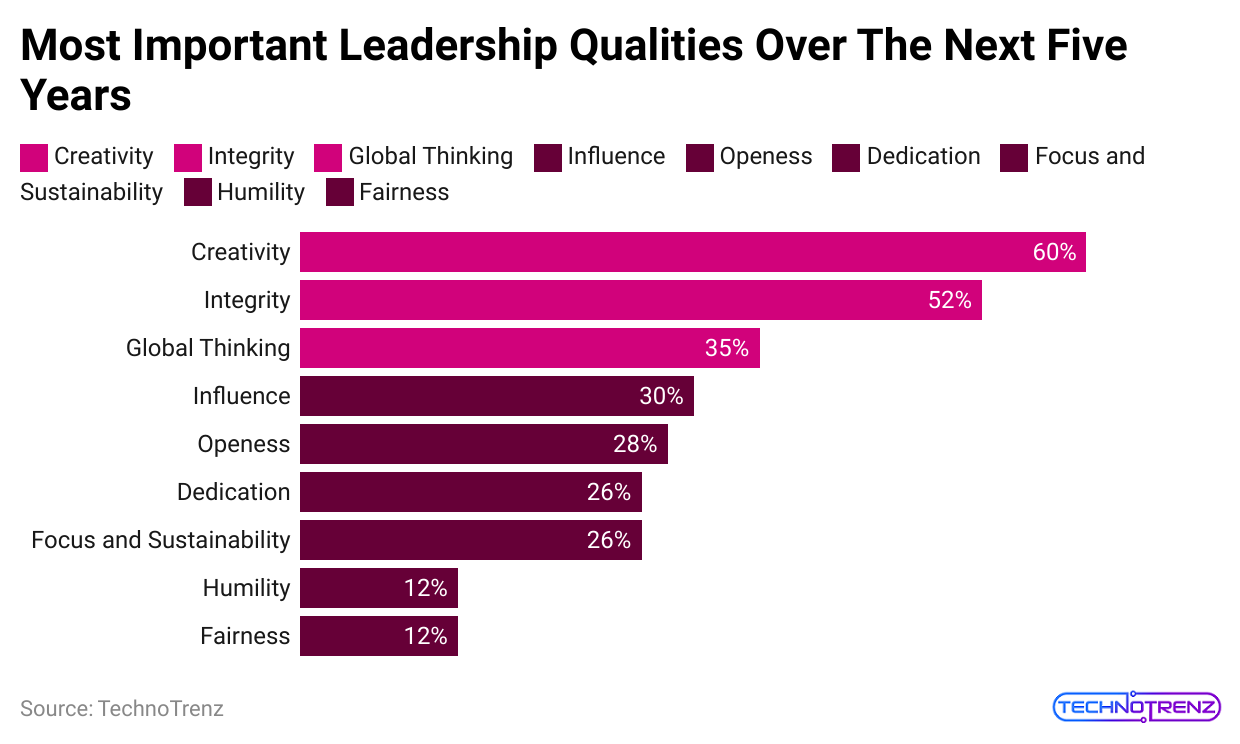 (Reference: wordpress.com)
(Reference: wordpress.com)
#1. Self-Awareness
Self-awareness is about understanding your personality, behaviors, worries, and feelings. It’s a key quality for leaders. Knowing your strengths and weaknesses helps you be a better leader. It’s important to see how others view you and how you come across at work and home. Take time to learn about the four aspects of self-awareness and how to improve each one.
#2. Respect
Respect is crucial for leaders. Showing respect consistently helps reduce tension, build trust, and improve your effectiveness. It’s more than just avoiding disrespect; it involves genuinely valuing others’ opinions and creating a sense of belonging at work. This supports equity, diversity, and inclusion.
#3. Compassion
Compassion goes beyond empathy or just listening. It means acting on what you learn from others. If someone shares a concern, they will feel truly heard if you take meaningful action. Compassionate Leadership builds trust, boosts teamwork, and reduces turnover.
#4. Vision
Vision is about having a clear goal for the future. Great leaders motivate others and align their team’s daily tasks with the organization’s overall direction. This helps employees find meaning in their work, increasing engagement, trust, and focus. Communicate your vision clearly so others understand, remember, and share it.
#5. Communication
Good communication is key to effective Leadership. It involves sharing information, telling stories, asking for input, and listening actively. Skilled leaders communicate well in various ways, both spoken and written, and with people from different backgrounds. How well leaders communicate affects the success of the business strategy.
#6. Learning Agility
Learning agility is the ability to handle new situations even when you don’t have all the answers. If you quickly adapt to new challenges, you’re already agile. However, anyone can improve learning agility with practice. Great leaders are also great learners.
#7. Collaboration
Collaboration means working well with a diverse group of people from different backgrounds and roles. In today’s complex world, effective leaders work across boundaries and organizational silos. Embracing collaboration leads to more innovation, higher team performance, and a more engaged workforce.
#8. Influence
Influence is the ability to persuade others using thoughtful tactics. Leaders need to influence others to get things done, as they can’t do everything alone. Unlike manipulation, influence must be authentic and transparent, requiring high emotional intelligence and trust.
#9. Integrity
Integrity means being consistent, honest, and trustworthy. It’s a vital trait for leaders, especially for top executives making big decisions. Organizations often overlook integrity, so it’s important to stress the value of honesty at all levels of management.
#10. Courage
Courage allows leaders and team members to take bold actions. It’s important for speaking up at work, whether proposing new ideas or addressing issues. Courage helps in doing what’s right and fostering a culture where people feel safe to express concerns without fear.
#11. Gratitude
Gratitude is the feeling of being thankful after receiving something valuable. It can improve self-esteem, reduce anxiety, and lead to better sleep. Expressing sincere thanks can make you a better leader. Even though many people appreciate being thanked, it’s rare for leaders to do it often. Good leaders regularly show gratitude.
#12. Resilience
Resilience is not just about bouncing back from setbacks but adapting to challenges. Resilient leaders maintain a positive attitude that helps others stay committed and overcome obstacles. Focus on resilience by caring for yourself and supporting your team’s well-being for better performance.
Conclusion
Strong Leadership is essential for businesses in many ways. Good leaders help keep employees happy and motivated, which can lead to higher profits. On the other hand, poor Leadership can hurt a company, contribute to health problems worldwide, and drive up healthcare costs. To address these issues, businesses must invest in leadership development programs to create better leaders who can handle a changing workforce.
Globally, there is a big market for improving leadership skills. However, many companies need to make the necessary efforts or give Leadership the attention it needs. By focusing on leadership training for women and minorities, companies can improve diversity at the top increase employee engagement, boost profits, and enhance their reputation.
Sources
FAQ.
Over 77% of organizations say they need stronger leaders. This isn't surprising since 10,000
Baby Boomers retire every day. Meanwhile, 83% of businesses think it's crucial to develop
leaders at all levels.
Companies with poor Leadership often face high employee turnover. Workers may leave to
find a better work environment where they feel appreciated and more positively challenged.
Poor Leadership can lead to a drop in overall team performance.
While leaders need to achieve results, their real value comes from their ability to inspire and motivate others.

Saisuman is a professional content writer specializing in health, law, and space-related articles. Her experience includes designing featured articles for websites and newsletters, as well as conducting detailed research for medical professionals and researchers. Passionate about languages since childhood, Saisuman can read, write, and speak in five different languages. Her love for languages and reading inspired her to pursue a career in writing. Saisuman holds a Master's in Business Administration with a focus on Human Resources and has worked in a Human Resources firm for a year. She was previously associated with a French international company. In addition to writing, Saisuman enjoys traveling and singing classical songs in her leisure time.











